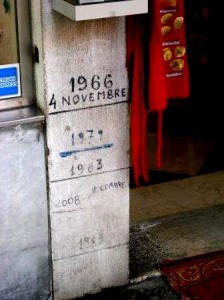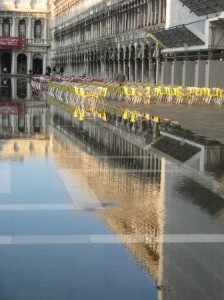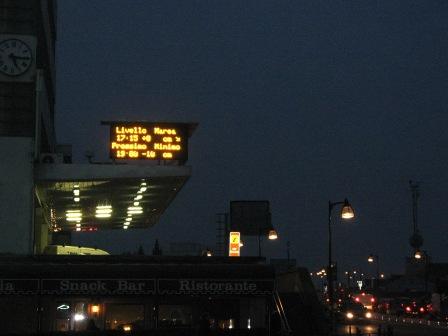Let’s start with the most basic fact of all: Venice is sitting in the middle of a tidal lagoon. This means surrounded by water that rises and falls. I don’t mean to keep harping on this, because I know it sounds really dumb, but not much dumber than all those stories that get published and broadcast that make it sound as if water on the ground here were stranger and more upsetting than four sharks singing “Shine On, Harvest Moon.”
How high the water will rise might vary from the official prediction based on a few factors, but when it’s looking imminent I’ve definitely got at least one eye on the barometer, the wind sock (on the computer) and the moon. Wait, that makes three eyes. Well, you know what I mean.

Data on the tides began to be recorded regularly after an exceptional high water in 1867 (153 cm above average sea level). In 1908 various monitoring stations were installed to more precisely measure the height of the tides, and in 1914 the pertinent data on the barometric pressure and the direction and force of the wind were added.
For events longer ago, historians can only turn to various chronicles and accounts in which the quantities aren’t always easy to assess. As in: “The water rose high enough to ruin the wells.” A flooded well would, in my view, be much more distressing than some water on the floor, seeing as the supply of fresh H2O in Venice was not infinite.
The main high-water factors are the following:
The season. If the acqua is going to be alta, it will usually be between September and April. Articles which refer to its frequency are often misleading because they use aggregate numbers which give the impression that it’s a monthly occurrence all year long. While there might be pesky clusters of high water events in winter (as happened this year), the likelihood plummets to June; it has never been recorded in July and August.
Phase of the moon. The tides are highest and lowest when the moon is full and when it’s new. Actually, the moon is the only component to this phenomenon which isn’t even the tiniest bit likely to swerve from the forecast.
Atmospheric pressure. When it’s low, the water is high. When it’s high, the water is low. If we tap on the barometer and see that it’s gone to the bottom of the scale, there’s no getting around the likelihood that the water will be high. The barometer won’t tell us how high, but we can look out the door and make a guess. A barometer is a great friend to have because it cannot tell a lie.
Wind. If the scirocco is blowing, it will definitely aggravate the situation. The scirocco is also obnoxious because it’s warm and humid (get one blowing in the summer and you’ll wonder if you took the wrong exit and ended up in Amazonia). But as it’s from the southeast, it will blow into the lagoon and — putting it very simplistically — push against the tide and prevent it from going out in a timely and efficient fashion. On the contrary, it seems to work very hard to keep all the water in the lagoon all at once. I try to avoid anthropomorphizing the natural world here, but I have to say that sometimes it seems like the wind just does it on purpose.
When a strong scirocco is blowing, I don’t hear wind so much as I do the heavy surf rolling up in close-order-drill on the Lido’s Adriatic beaches. It’s a deep, rumbling sort of roar off in the distance, impossible to mistake for anything else.

There is a warning system to alert the city that within an hour, water will be rising in the Piazza San Marco (the lowest point in the city) and, by extension, at other various low-lying areas. This information comes from a monitoring system at the mouth of the lagoon at San Nicolo, and at other points in the lagoon.
Until two years ago, the citywide warning system was a few sirens which emitted a sequence of rising wails. The first time I heard them they woke me from a deep sleep in the middle of the night — a sudden violent tone swooping upward, overlapped by another one just following it, and then by a third. Scared the hoo out of me — it was like the Three Weird Sisters in Macbeth going mad.
But what they didn’t tell you back then was how much water was going to come ashore.
Two years ago, the system was refined. Now there is only one siren-swoop, after which comes a steady tone which indicates the maximum predicted height. One tone = 110 centimeters above sea level. Two tones = 120 centimeters. Three tones = 130. And four tones = 140 and above. This is what they sound like. I can tell you they’re very effective. There may not be any way you can ultimately prevent water from coming indoors, but you cannot possibly say you had no warning.

